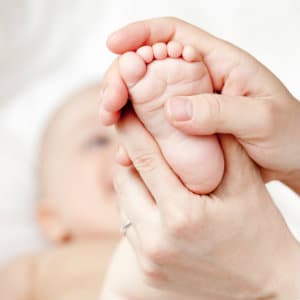Hope for Babies with Complex Clubfoot
You may find out from an ultrasound during pregnancy, or as an unwelcome surprise in the delivery room, but you’ll never forget the first time you hear that your baby has clubfoot. The foot deformity is fairly common (about 1 in 1000 births), but that doesn’t make the diagnosis any less devastating. At Southern California Foot & Ankle Specialists, we can take the sting out of the unwelcome news. There is a way to correct your little one’s twisted feet without major surgery, and we can usually treat even complex clubfoot right here in our office in Ladera Ranch, CA.
A Quick History of Clubfoot Treatment

Despite its success, the treatment was not widely known until the dawn of the Internet, when parents began connecting online to find an alternative to surgery for their little ones’ feet. Since then, many patients have been treated by Dr. Ponseti from all over the world, as have medical and other providers all over the world have come to train and learn the proper procedures for the Ponseti method of correcting clubfoot. Dr. Nitza Rodriguez was fortunate to be one of them, and she brought that expertise back to our practice here in SoCal.
A Simple but Skilled Treatment for Complex Clubfoot
This term refers to an unusually serious case that includes rigid equinus (tight heel cord that doesn’t allow the foot to be bent upward), severe plantar-flexion (toes pointing down away from the leg), a short first toe, and deep creases on the sole, above the heel, and sometimes in the calf. The Ponseti method can usually work even in such a severe case, although it may require a few extra castings and thus take a little longer.
There is quite a skill involved in being able to feel how the bones in these tiny feet and ankles lie, and where pressure needs to be gently applied to gradually move them into the correct position. You don’t want to trust the process to someone who has not been fully trained, which is why you can relax when you know Dr. Rodriguez is handling your baby’s feet. She gently molds and holds the feet in place while the plaster cast is applied from toes to hips. You can see more about the whole process in our case study.
The Reward: Children Running and Playing Normally
It is such a pleasure to see the joy on the faces of the parents and the immediate difference in the baby’s feet even as the first cast is removed. The transformation after the last one comes off is what keeps us enthused about specializing in treating clubfoot. To think that these little ones will have a chance to grow, stand, walk, and run around normally without disfigurement and pain is almost miraculous.
If your baby has been diagnosed with clubfoot, watch the inspiring video A Walking Miracle about Dr. Ponseti’s treatment. Then call Southern California Foot & Ankle Specialists at (949) 364-9255 (WALK) to set up the first appointment for your baby, or do it right on our webpage while you are online.
We are proud to be a part of the movement to treat this deformity around the world without the pain and side effects of surgery.
Contact Us
Ladera Ranch
333 Corporate Dr. Ste 230, Ladera Ranch, CA 92694
Tel: (949) 364-9255 (WALK)
Fax: (949) 364-9250
Office Hours:
Monday - Friday: 9am - 5pm
*(Lunch 12 noon - 1pm)
Orange
2617 E Chapman Ave. Ste 303, Orange, CA 92869
Tel: (714) 639-7993
Fax: (714) 639-0729
Office Hours:
Monday - Friday: 9am - 5pm
*(Lunch 12 noon - 1pm)
